Have you ever thought about blending the peaceful vibes of the East with the practicality of the North? If you have, you’re definitely not the only one! In this article, we’ll talk about Japandi style, which is all about combining Scandinavian and Japanese design elements in your home decor. We’ll show you how to incorporate earthy items, clean lines, and neutral colors to create a calm and serene atmosphere in your living space.
I find Japandi really intriguing because it’s all about creating spaces that are cozy and aesthetically pleasing, without making them feel cramped. By the time you finish reading this article, you’ll have a good grasp of Japandi style and be all set to incorporate its ideas into your own home!
The Story of Japandi Style: A Fusion of Eastern and Nordic Influences
I absolutely love the mix of ideas in design, and that’s why I’m so inspired by the Japandi home look. It’s a contemporary minimal style that combines Japanese wabi-sabi and Scandinavian hygge vibes. Both cultures value simplicity, peace, and well-crafted items, so it’s no wonder that they blend so beautifully together. The result is decor that not only looks good but also serves a purpose. It’s all about finding beauty and functionality in every piece.

Have you heard of Japandi style? It’s all about incorporating tidy oak pieces, soft padding around table corners, floor mats inspired by tatami mats, and calming, toned-down colors in your decor. The cool thing about this style is that every object in your home serves a purpose, not just for looks. By mixing Japanese low-profile furniture with Scandinavian wood designs, you can bring both cultures together in one room. How awesome is that?

You know, I really believe that mixing old and new design styles can totally transform your everyday life. I recently added a cool ash wood bench in my entryway. Not only does it provide a comfy spot to sit, but it also really ties the whole area together. I read in Architectural Digest that this whole Japandi trend is on the rise because it’s all about creating spaces that promote wellness and coziness. Such a cool concept, right?
You know, it would be really cool to learn a bit about Danish mid-century design because it can really enhance your understanding and appreciation for this minimalist style.
Discover the Essential Components of a Japandi-Inspired Home decor
Before you jump into designing, let’s chat about the key elements of Japandi interiors. It’s all about finding that perfect balance between soft and structured, warm and neutral, and form and function. It’s super important to pay attention to detail. Every item you choose for your living room should not only be practical but also beautiful. By creating a calming space, you’ll have a spot that really helps clear your mind.

In these homes, you’ll find low sofas, open shelving units, and neutral rugs to create a cozy vibe. I love using natural materials like bamboo lamps and ceramic vases to keep the décor simple and elegant. Japandi style focuses on a more minimalist and craftsman-like approach rather than being flashy.

So, whenever I’m designing a room, I always stop and ask myself, “Does everything here serve its purpose?” Even little things like a wooden tray or a decorative branch can add so much to the overall vibe. The folks at Dwell suggest that sticking to this mindset can keep your home feeling intentional and less cluttered with random decor.
When you’re just starting out with decorating, it’s a good idea to start by getting a platform bed and a nice natural wood dining table. You can then plan the rest of the room layout based on these key pieces.
Unveiling the Wisdom of Creating a Japandi Home
I personally feel that being in a Japandi space is about more than just picking a style – it’s all about embracing a certain mindset. It’s all about mindfulness and being intentional in your choices. Both Japanese and Scandinavian cultures value quality over quantity. When I’m in a Japandi-inspired space, I feel like I can truly unwind and take a break from the hectic pace of everyday life.

I think it’s nice to have a white dining table that can double as a workspace. I always notice how people have a few meaningful pieces of wall art in their homes, whether it’s calligraphy, abstract shapes, or handmade textiles. It’s clear that the things we choose to surround ourselves with hold a special meaning to us.

Out of all the spots I’ve set up in my place, I absolutely love my reading nook the most. It’s got that cozy Japandi style vibe with just a comfy chair, a soft blanket, a floor lamp, and a textured wall that all come together perfectly. I read on The Spruce that Japandi rooms are said to reduce visual stress and help you feel calm. So cozy and relaxing!
Wellness design has become all the rage lately, so why not add some lovely scents or soothing sounds to your space with a diffuser or maybe a little water feature? It could really help create a more relaxing atmosphere!
Neutral Color Palettes For A Calm Atmosphere
Have you heard of Japandi design? It’s all about creating a peaceful and calming atmosphere by using simple and soothing colors like stone gray, warm beige, charcoal, or soft white. These colors work together to create a harmonious balance in any living space, making it feel serene and inviting. They really set the tone for a cozy and relaxing vibe.

When I start decorating a room, I always like to choose a wall color that sets the tone. I usually go for off-white or a cozy soft gray clay because they create a calming atmosphere. Then, I love adding natural elements like walnut coffee tables, light oak chairs, and linen curtains to bring warmth and a sense of peace to the space. And don’t even get me started on textured fabrics in gentle hues – they really take the comfort level up a notch while keeping everything looking airy and inviting!

I think neutral tones don’t have to be boring at all – they can actually be really classy. My bedroom is painted a cozy gray with white accents, and I added some blush cushions to make it feel even cozier. I read in Elle Decor that sticking to similar shades for different pieces can help keep a room from feeling too overwhelming.
If you’re not sure about using neutral colors, why not start by adding some soft-toned throw pillows or ceramics to your decor? Then you can gradually move on to larger items like rugs or painting the walls in neutral shades. It’s a fun way to ease into it and see how it looks in your space!
Minimalist Layouts With Purpose
In Japandi style, we pick pieces that keep our space organized and practical. When I design a minimalist room, I focus on highlighting the space itself rather than cramming it full of stuff. An open layout creates a cozy atmosphere and gives your eyes a chance to relax. It’s all about selecting what is essential, rather than just getting rid of things.

I always take care to arrange the furniture in a way that flows nicely with the rest of the room. For instance, I like to use sectionals with a low profile to define a space without it feeling too closed off. I also believe in functional design, so I make sure to include floor lamps, open shelves, and a simple dining table to keep things organized. In Japandi style, every piece of furniture placement is important, so I really think about all the little details!

In our client’s living room, we decided to go with a versatile couch and a coffee table with an open bottom. This way, everyone can easily connect and interact from any spot in the room. And remember, to keep your home looking balanced and cozy, House Beautiful recommends not cramming too much furniture into your floor space. Just let things flow naturally!
In a lot of minimalist Japandi rooms, one thing that’s often lacking is that upward focus. You can bring more height into the room by adding a small sculpture on the wall or a tall, slim lamp. Just a little something to draw the eye up!
Experience the Japandi Vibe with Natural Materials
You know what’s really cool about using organic materials in Japandi design? They’re so transparent and just add a special touch to the space. I always recommend incorporating natural fibers and woods like linen, cotton, wool, bamboo, and oak because they bring in that cozy warmth and texture that makes the room feel super genuine. It’s all about creating a natural vibe and that’s a big part of Japandi design.

I love incorporating natural elements like raw wood beams, rattan items, pottery, and paper lanterns into my decor. Not only do they look great, but they also feel really nice to touch. I also like to add jute or wool rugs for a cozy feel, and use clay pottery as both decorations and storage. It just adds a nice touch to my space!

A lot of my clients have told me that they feel so much calmer and at ease when they’re in a room that’s decked out with nature-inspired decor. It’s not just about looks, either – according to Better Homes & Gardens, having natural materials around can actually make the air we breathe cleaner and healthier.
If you want, go ahead and add some live plants in cute woven baskets or toss in a few natural stone decorations to really embrace that organic vibe.
I really love the way Japanese and Scandinavian furniture blend together in Japandi design. They just seem to complement each other so well! I like to mix things up by pairing simple Japanese seats with stylish Scandinavian chairs. It creates a really nice, balanced look in the space.

I love pairing a cozy futon mattress from Japan with a stylish nightstand from Denmark in my home. When I have interviews, I always sit on my comfy Scandinavian bench. And for more casual meals, I like to gather around my Japanese chabudai table. I find that using birch and beech wood together gives a nice balanced look to the room.
You know, I believe that combining these methods really makes the space stand out and feel more personal, rather than just looking like a typical store display. I read in Domino Magazine that incorporating different cultural elements also helps to maintain a sense of simplicity in the style.
Hey there! Just wanted to point out that Scandi furniture tends to be taller than traditional Japanese pieces. Mixing up heights can definitely give your space a cool vibe, but remember to keep things in harmony for a well-balanced look.
Transforming Chaos into Order: Beautiful and Practical Storage Ideas
In Japandi interior design, having practical storage options is key! I always recommend using clever hidden cupboards, wall shelves, or multipurpose units to keep your belongings in order. It’s all about maintaining a tidy and minimalist look while also catering to your daily needs. The storage solutions in Japandi spaces do more than just make things easier—they also contribute to the overall ambiance of the room.

When it comes to storage, I usually go for pieces that have a minimalist design, sleek finishes, and easy-to-use handles. I’m a big fan of sliding cabinet doors, storage boxes that can slide under the bed, and cool floating shelves. I find that light wood or a matte white finish goes well with any neutral color scheme in my home. You might also want to consider getting a bench or coffee table with hidden storage compartments for added functionality. It’s all about finding pieces that not only look good but also serve a practical purpose!

So when I was putting together my new hallway design, I decided to add a vertical oak unit with pull-out drawers. It really helped maximize storage space without overcrowding the room. I read in Real Simple that it’s a good idea to place storage in plain sight and make sure it complements the rest of the decor with natural and clean lines.
When it comes to smaller items, I often recommend using cute decorative baskets or fabric bins in nice, soft colors. They not only keep things organized but also add a nice touch to your design.
1. Simple Elegance: Sleek Furniture for a Stylish Home
In Japandi interiors, the key is to keep things simple and focus on clean lines. I believe that furniture with minimal and low designs really opens up a space and guides your eye smoothly around the room. Rather than being flashy, each piece contributes to a calm and peaceful vibe.
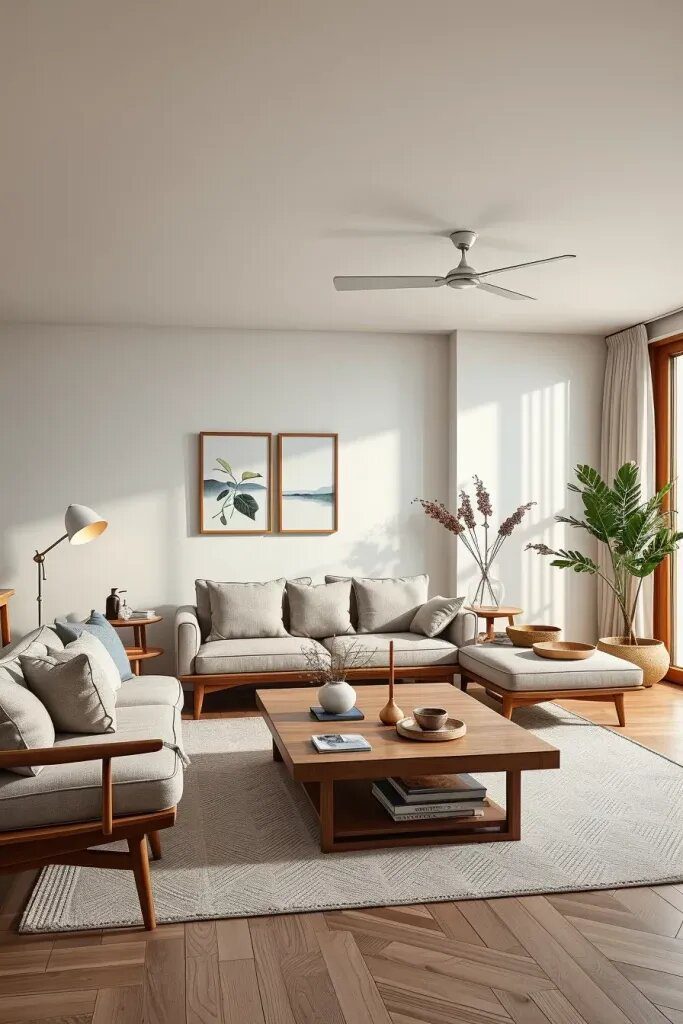
I love lounging on my cozy Japanese-style sofa that sits low to the ground, surrounded by my favorite Scandinavian spindle-back chairs. My sideboard has a sleek and clean design that complements the minimalist vibe of my space perfectly. I like to keep things simple with rounded edges and a soft overall look. And my oak coffee table with rounded corners ties everything together nicely while adding a touch of warmth to the room.

From what I’ve seen, designs that follow those principles really help with keeping your mind focused. When there’s not a lot of busy patterns or crazy shapes catching your eye, the room feels a lot more peaceful. According to Better Homes & Gardens, using slim furniture can make your living area look and feel more spacious.
You know, if I wanted to take this to the next level, I’d really emphasize the importance of proportion. It’s all about getting furniture that fits your space just right, instead of overcrowding it. Making sure there’s a good balance between the different areas and the pieces themselves is key in creating that Japandi vibe.
Embracing Imperfection and Finding Beauty in Wabi-Sabi Style
I really love Japandi design because it embraces the wabi-sabi philosophy, which encourages us to embrace imperfections and the beauty of aging. I’m drawn to items that have unique imperfections, like a handcrafted vase with a little glaze drip or reclaimed wood with knots and cracks. These little marks show the history and character of the piece, giving it a special soulful touch.
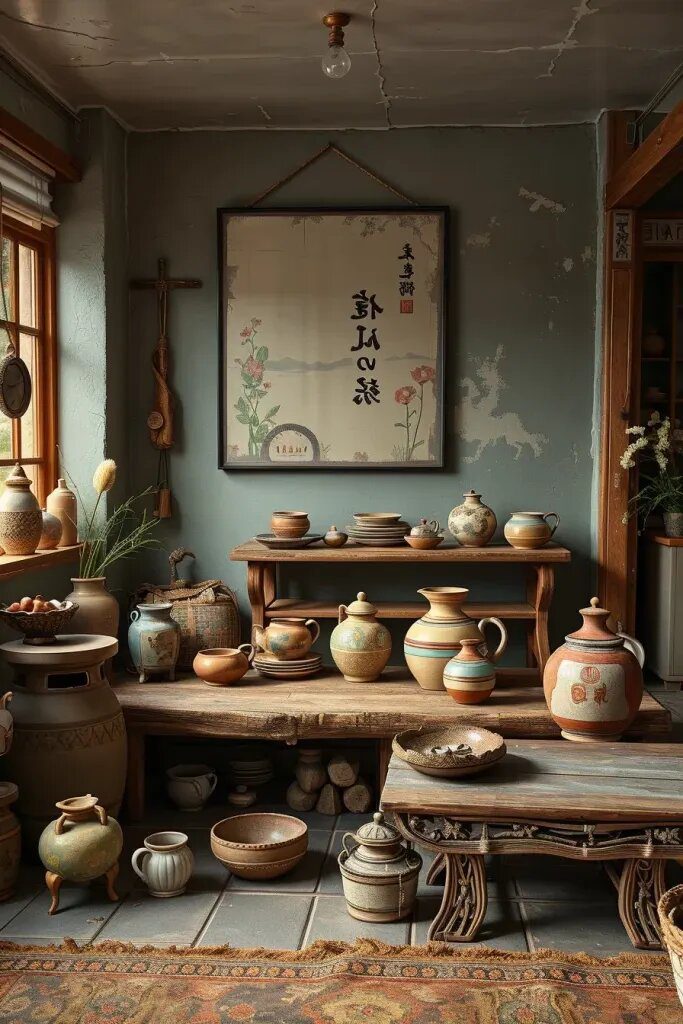
You can bring wabi-sabi vibes into your home by adding things like old copper fixtures, worn-out linen, or handmade pottery. I love mixing in quirky pieces, like an old mirror or a chipped ceramic bowl. These pieces aren’t just random—they represent a life that’s full of meaning and character, rather than striving for perfection.

I’ve noticed that clients really start to connect with the handmade pieces in my designs. They bring a special touch to the overall vibe. Architectural Digest suggests mixing in classic or imperfect pieces in modern homes to give them more personality and charm.
You know, something I’ve noticed a lot in modern interiors is that they can sometimes feel a bit soulless. That’s where Wabi-sabi comes in – it really adds that extra touch of character. I always suggest adding in a piece that has a story behind it, like maybe a worn wooden stool that has been in the family for generations. It really helps create a more personal and cozy vibe in any space.
I really love the concept of Japandi because it combines the clean lines of Japanese design with the cozy vibes of Scandinavian style. It just makes my home feel so inviting and well-organized. I like to throw in some soft textures, nice lighting, and a few personal touches to make it my own, while still keeping things minimal and uncomplicated.
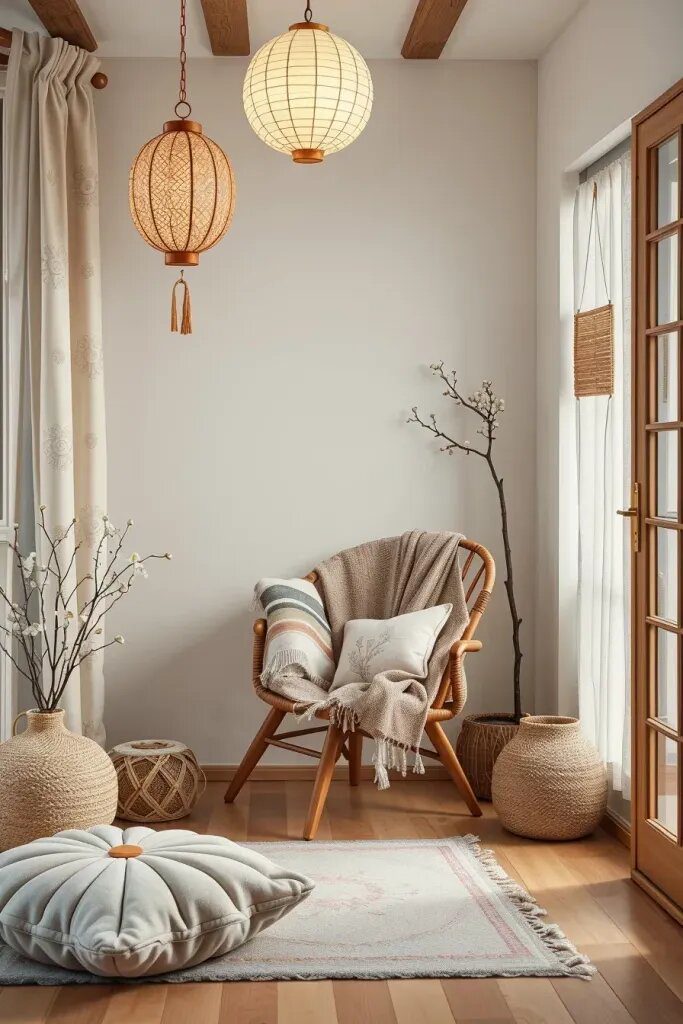
You know what would be super cozy? Picture a soft wool throw draped over a cool modern chair, or maybe a knitted pouf next to a low coffee table. And how about adding a candle holder, either ceramic or metal, straight from Scandinavia? It’s the perfect touch for a little romance. In Japandi style, it’s all about layering for comfort without going overboard. So I always make sure that every comfy item has its place and purpose in the room.

So, when I was setting up my kitchen, I decided to go with a Japanese table and pair it with two cozy Scandinavian chairs covered in soft gray wool. The mix of styles really brought a sense of comfort and simplicity to the space. I think combining Hygge with minimalist designs was a great idea to make the room feel warm and welcoming, rather than stark and cold. Elle Decor definitely knew what they were talking about!
Have you thought about hanging up some paper lanterns or using floor lamps with dimmer switches? It really adds a cozy and welcoming touch to your home, making it feel loved and inviting.
Bringing the Outdoors Inside: A Japandi Design with Natural Light
When I design Japandi homes, I make sure to fill them with plenty of natural sunlight. It’s not just about brightness, it’s also about shaping the overall design of the space. I pay close attention to how light flows through the rooms, placing furniture strategically to make the most of it and selecting materials that sparkle in the sun. The aim is to create a space that feels open, simple, and connected to the outdoors.

I find that using sheer curtains, paper shades, or plain linen drapes gives off the most beautiful light effect. Another trick I like to use is placing a mirror across from a window as it really opens up the room and makes it feel brighter. I also make sure not to block windows with big pieces of furniture. Just some tips that I’ve found really make a difference in how a room looks and feels!

So, the other day we decided to swap out our heavy blackout curtains for some light and airy white sheers in our house, and let me tell you, it made such a difference! The sunlight streaming in really highlighted all the beautiful details in our wooden furniture, pottery, and fabrics. I read in Domino Magazine that natural light can really enhance the look of Japandi designs with their focus on natural materials. It’s amazing how something as simple as changing your curtains can totally transform the feel of a room, right?
If you’ve got a spot that could use a bit more light but doesn’t have many windows, consider giving some warm LED lights a shot. Just aim them towards the ceiling so the light bounces around and doesn’t shine directly in your eyes.
Wood, Bamboo, And Linen As Core Textures
In the world of Japandi design, we really value both how something feels and how it looks. That’s why I love incorporating materials like wood, bamboo, and linen into my style – it’s all about achieving that perfect balance of elegance and simplicity. These elements come together to create a space that just feels so inviting and natural, helping to really enhance its overall appeal.

I love to pair pale oak flooring with bamboo pendant lamps and linen fabric. It just creates a cozy and welcoming feel in the room. Adding a walnut bookshelf with a matte finish or some linen-covered chairs can give your space a sleek and sophisticated look. It’s all about finding that perfect balance between minimalism and elegance.

I put together this living room design with a rattan lounge chair, a light oak side table, and linen curtains, and my friends absolutely loved it! They mentioned feeling so relaxed and like they were hanging out in nature. I read on The Spruce that Japandi style focuses on using sustainable materials that are not only good for the environment but also feel great to be around.
To really amp up the style, consider adding a cozy woven rug or some unique handcrafted ceramics. These little details can really enhance the room’s vibe and bring all its features together seamlessly.
Embracing Nature’s Harmony: Bringing the Outdoors Inside with Indoor Plants
You know, adding plants to Japandi interiors isn’t just for looks – it really helps bring a touch of nature inside. I’ve found that having plants around brings a sense of peace and simplicity to a minimalist space without overwhelming it with stuff. And not only do they look great with the neutral colors and natural materials of Japandi style, but they also help purify the air and boost your mood. It’s like having a little piece of the outdoors right in your home.

I like to put my rubber trees, fiddle leaf figs, or bonsai on wood shelves by the window. If you’re into Japandi style, natural stone or ceramic planters are perfect. I love hanging planters made of jute or bamboo too. Just make sure whatever you choose is easy to care for, so your space stays nice and tidy!

I’ve noticed that my workspace feels so much more peaceful ever since I added some snake plants and peace lilies in simple, modern pots. It’s cool to see top designers like Bobby Berk talking about how bringing in nature can really calm the mind and clear things up. It totally fits the laid-back vibe of Japandi style, don’t you think?
You know, one thing we tend to overlook is lighting when it comes to plants. They really need it to thrive! If you’re going for that cozy Japanese or Scandinavian vibe in your home, try placing your plants by big windows or using some gentle LED lights. It will not only make your plants happy but also create a nice ambiance in your space.
How to Design a Cozy Living Room with a Japandi-Inspired Touch
So, when you’re creating a Japandi vibe in your living room, the key is to declutter and think about how everything flows together. Keeping things simple, with sleek furniture and room to move around, is key in a cozy kitchen. A Japandi living room brings together functionality and tranquility, with lots of sunlight and a peaceful atmosphere to relax in.

I really love a sofa that’s not too dark or too light, with wooden legs. A big woven area rug ties the room together, and a coffee table with a cozy matte finish is perfect. I prefer cushions made of linen or organic cotton. Adjustable screens or wood-slatted shelves are both functional and stylish for storage. I also like furniture that sits close to the ground, inspired by Japanese and Scandinavian design principles.

I’ve noticed that when you mix in some oak wood and black metal frames, it really gives the room a modern touch. According to Architectural Digest, adding in some soft wool throws and jute rugs, along with keeping minimal pieces in the room, makes everything feel more cozy and inviting.
Having a room that feels too plain or too cold can really miss the mark on creating a cozy atmosphere. So why not add a little something special to your Japandi room? Consider throwing in a comfy tatami cushion or a stylish woven pouf for some extra comfort and a nice spot to sit down and relax. It’ll definitely help make your space feel more inviting and warm!
Creating A Japandi Bedroom Sanctuary
In a Japandi bedroom, our main aim is to create a peaceful and calming vibe. We choose soft, soothing colors that are perfect for unwinding at the end of the day. With minimal furniture and natural materials, the space is designed to help you relax. Ideally, waking up in Japandi style should leave you feeling content and refreshed, instead of overly energized.
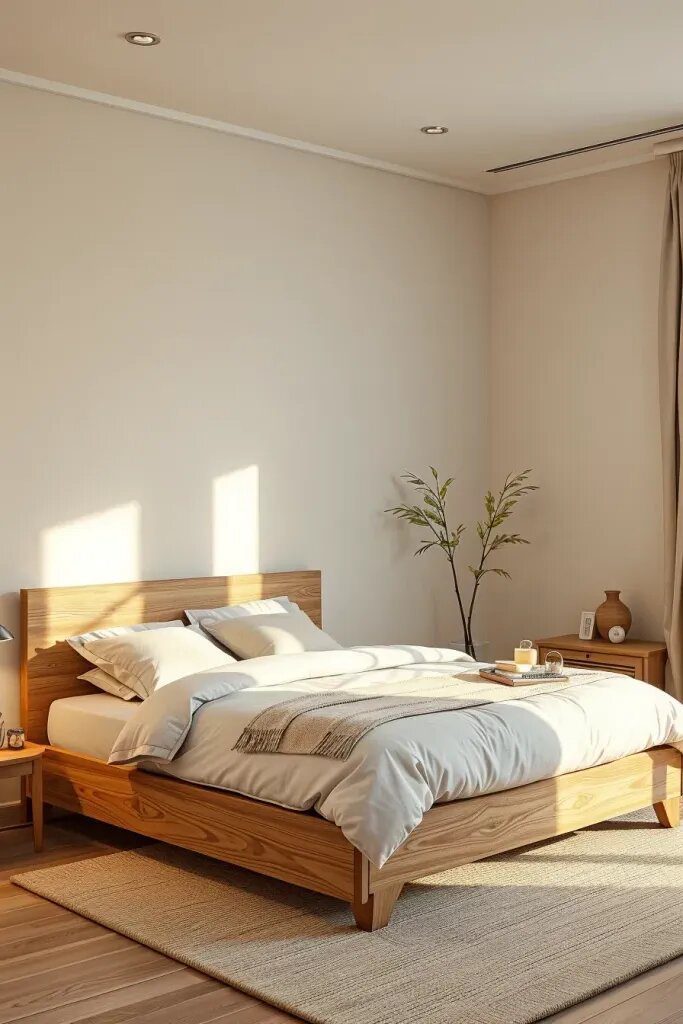
I suggest a platform bed made from either oak or ash wood, topped with some soft linen bedding in a calming beige or grey. For a cozy touch, add a simple bedside table, a warm clay lamp, and a few of your favorite books or plants. To keep the room feeling peaceful and organized, consider incorporating storage options that are either cleverly hidden or built into the walls. This will help create a serene and inviting atmosphere in your bedroom.
I’ve actually found that I sleep a lot better when I use this method. The designers at House Beautiful also mention that the key is to create a sense of order and add enough shape to make the room cozy without it feeling too cluttered.
Have you ever thought about what’s missing in your space? Sometimes it’s the peacefulness of quiet sounds. You might want to try adding a cork accent wall or some thick wool curtains to keep things cozy and serene, especially if you live in a noisy area. Just a little tip to make your space more tranquil!
Japandi Kitchen Design For Modern Lifestyles
The kitchens in these homes aren’t just functional, they’re also gorgeous. I always make sure to prioritize practicality – like using open shelves, keeping counters clear, and incorporating stone and wood into my designs. I believe every corner of your home should have a purpose and feel unique.

When picking out cabinets for your kitchen, go for a matte finish in colors like white, sage green, or charcoal. Consider using wood or bamboo for your countertops and fixtures to add a natural touch. Instead of harsh overhead lights, opt for softer cooking lights under the cabinets. Add some charm by displaying handmade ceramic bowls on your kitchen shelves. Incorporating black metal fixtures can give your space a trendy, modern feel. Be cautious with chrome or glossy finishes as they can come off as too harsh in the kitchen.
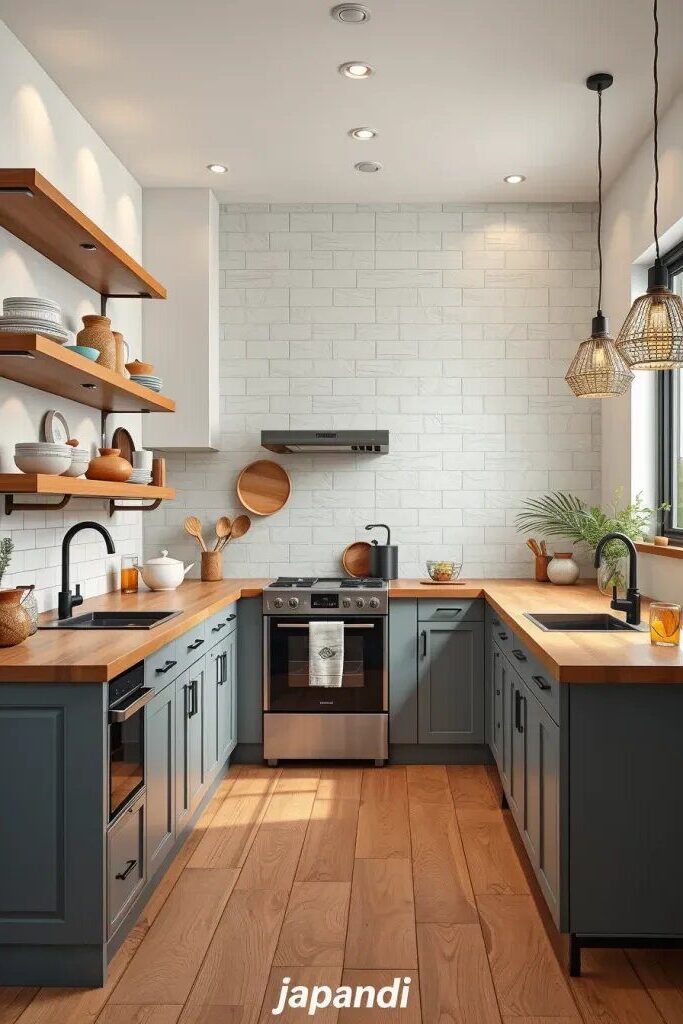
I decided to switch out my cabinets for wooden open shelves in my home to keep the space feeling bright and airy. I read in Dwell that open Japandi kitchens are gaining popularity because folks are putting more emphasis on both style and practicality these days.
When you’re in the interview, remember to pay attention to the little things, like the flooring. I would suggest going for wood or cork boards in soft oak colors. They not only add a cozy warmth to the room but also complement the whole Japandi aesthetic we’re going for.
Discover 5 Relaxing Japanese-Inspired Bathroom Ideas
In Japandi design, bathrooms are all about creating a peaceful and serene space that helps you relax and recharge. When I decorate my garden, I love using warm, earthy colors and soft textures to create a cozy atmosphere. I also try to incorporate natural finishes whenever I can. It’s important to bring mindfulness into your daily routine and really focus on being present in everything you do. Give it a try!
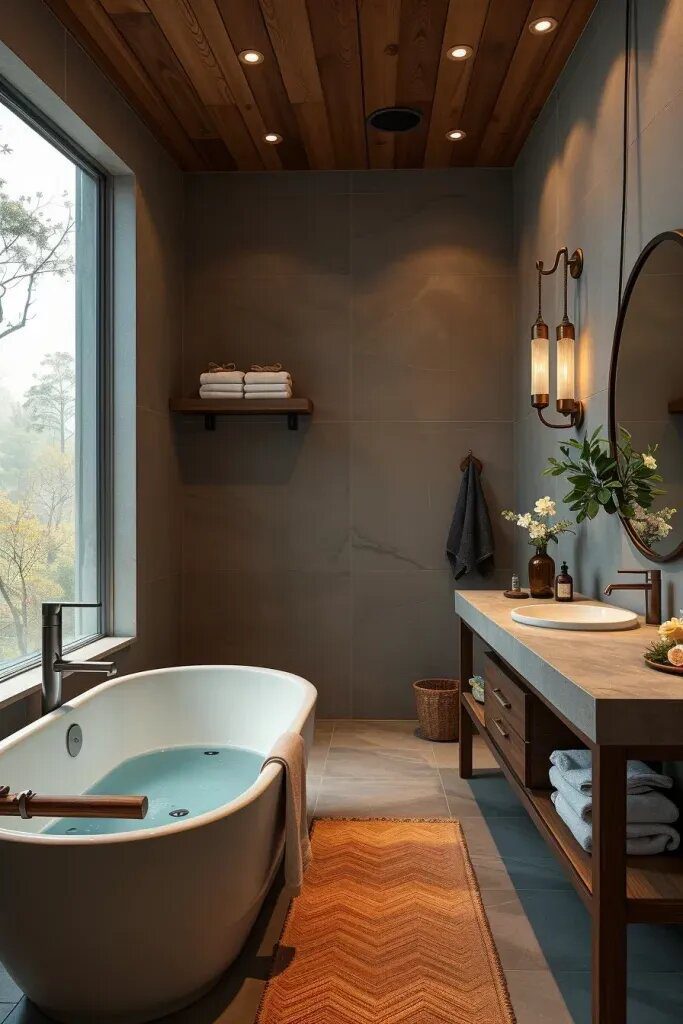
You know what’s really nice? Having a big soaking tub if you’ve got the room for it. We love the idea of it being made out of stone or a cool matte white ceramic. And for a bath mat, how about using some wooden slats? Pair that with a floating wooden vanity, a sleek brushed brass or black wall-mounted faucet, and some natural stone countertops. If you can, go for natural sunlight, but if not, some warm-toned light bulbs that you can adjust would be great. Just picture yourself relaxing in there – sounds like a dream, right?
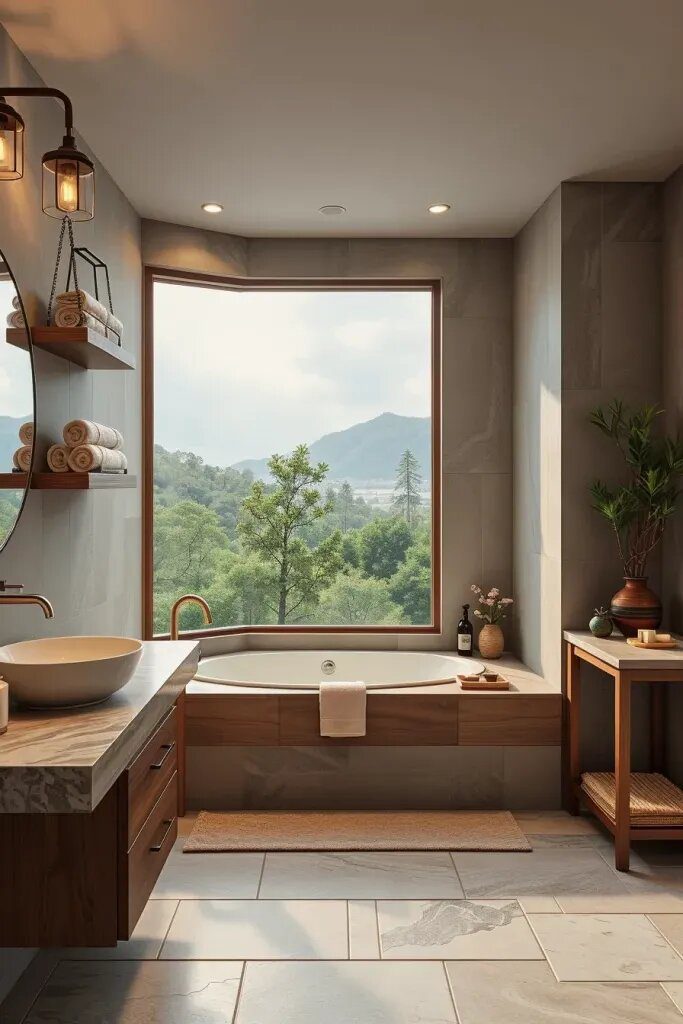
I’ve found that using a pretty ceramic vase with some eucalyptus branches and draping linen towels around is a nice touch in my home. According to the experts at Elle Decor, mixing large tiles with wood accents creates a nice, balanced look in a room.
Have you noticed how some Japandi bathrooms can feel a bit cold and impersonal? To make it cozier, try adding a linen shower curtain and a lovely scented soy candle. It’s a simple way to give the room a personal touch.
Tips for Creating a Cozy Japandi-Inspired Entryway
Your entryway sets the vibe for your whole Japandi home, so it’s important to get it right. Here’s what I suggest: keep the design simple, make sure it’s easy to walk through, and only decorate with the essentials. Opt for calming colors and incorporate natural materials right as you walk in the door.

If you want to create a cozy and welcoming Japandi entryway, try adding a narrow wooden bench with shoe storage underneath, a simple coat rack on the wall, a jute rug, and a large round mirror. Keep things organized by placing keys on a tray and storing scarves or gloves in a woven basket. To make the space feel inviting, add warm lighting and clean lines. Just imagine coming home to a space that feels both stylish and comfortable!

Hey there! I’ve popped a diffuser in the hallway, filling the air with the calming scents of hinoki wood or sandalwood, just to give you a warm welcome when you walk in. According to Real Simple, having a clutter-free entryway can really help reduce stress, which is exactly what the Japandi style is all about!
Have you ever noticed that most entryways are missing one key thing – artwork? It’s such a simple way to add character and personality to a space. Why not try starting with a vertical ink brush painting or a calligraphy scroll to bring in some Japanese customs? It’s a fun way to spruce up your home and make it feel more inviting.
Open Concept Spaces With Flow And Balance
No matter where you are, the different areas in Japandi open-concept homes should just flow together nicely. I always make sure that the colors, flooring, and design all match up from room to room. Keeping things consistent with the same color helps to keep your mind clear and make the space feel cohesive.

Hey there! So, for the living room, it’s best to stick with neutral wood tones like white oak or ash. Consider placing some big rugs in the areas where you envision the living and dining spaces, even if there aren’t physical walls separating them. It’s also a good idea to incorporate similar design elements throughout the different rooms, like slatted panels or lamps. Try to match the wood colors nicely and keep the styles slightly contrasting for a cohesive look. Hope that helps make your space feel warm and inviting!

You know what I’ve noticed? Those sliding partitions or vertical wood slats are great for dividing up a room without making it feel closed off. The folks at Domino suggest using furniture that can be easily moved around and playing around with different lighting options so you can do all sorts of stuff in the same space. Pretty cool, right?
If you’re looking to spruce up your space, you could try adding a cool feature like a tiny rock garden or maybe a bonsai set to bring the whole area together. Just a little touch to make it feel more connected and special!
The Role Of Texture In Japandi Interiors
In Japandi style, we aim to keep things engaging and cozy by focusing on texture rather than going overboard. I love adding different layers of texture to a room to create a balanced and inviting atmosphere. It’s all about making sure that minimalism doesn’t feel cold or boring; instead, texture adds a touch of beauty that enhances the functionality and simplicity of the space.

One of the combinations I absolutely adore is mixing raw wood with cozy woven accessories, soft wool rugs, rattan lighting, and ceramic pieces. I like to blend soft textures like linen with sturdy furniture or rugs. I believe that every element in a home should complement each other and not feel cluttered or overwhelming.

I’ve noticed that adding different materials can really help people relax and feel more at ease. For example, I once worked on a Japandi bedroom for a client that was feeling a bit bland. By incorporating a cozy boucle throw, a couple of ribbed ceramic vases, and a chunky wool ottoman, the room instantly felt cozier and more connected to nature. According to Elle Decor, the Japandi style is all about quality over quantity, and adding texture really highlights that concept.
You know, sometimes we forget to mix things up a bit and add some vertical texture when decorating our homes. Personally, I feel like adding a fabric wall panel or some light wood slats really ties the walls in with the rest of the furniture. Just a little tip to make your space feel more cohesive and inviting!
Find the perfect lighting for your cozy Japandi living space
When designing Japandi homes, I always make sure to keep things cozy and peaceful, blending the best of Scandinavian and Japanese styles. I like to think about how natural light and different types of lighting can create a calming atmosphere throughout the day in each room.
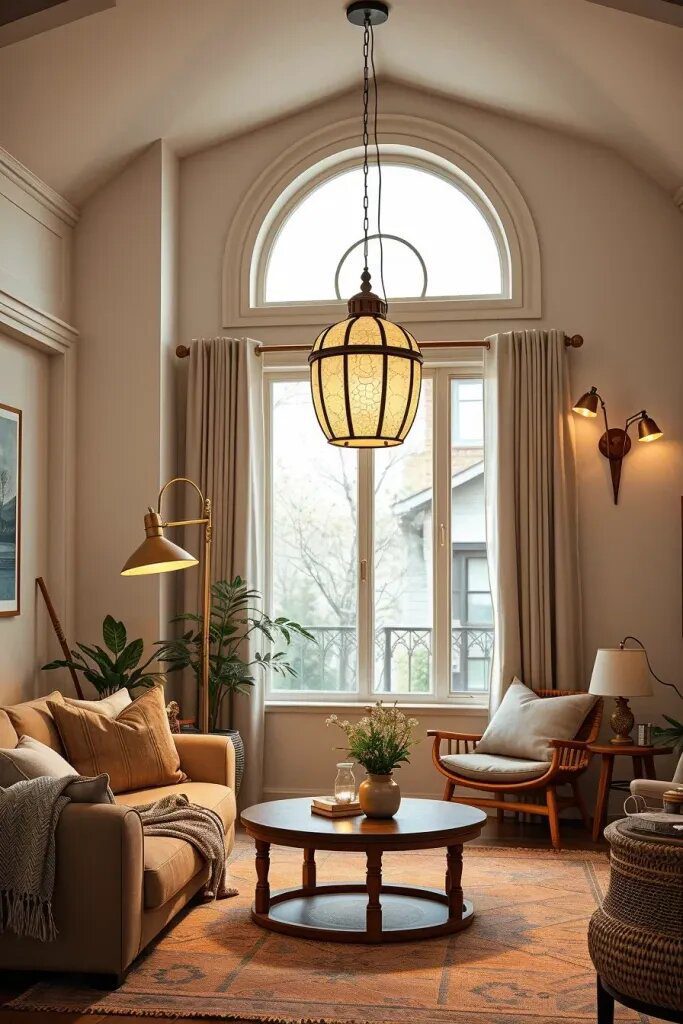
I really like to use simple paper lantern pendants, wall sconces in a matte black or brass finish, and floor lamps with a wooden stand and off-white linen shade. I believe that controlling the lighting in a room is important, which is why I always opt for dimmable bulbs. Whether you need bright ceiling lights, task lighting by your desk or bed, or cozy candles, I’ve got you covered!

You know, I used to not pay much attention to lighting in my home. But once I tried out the Japandi style and switched the harsh white bulbs to cozy soft LEDs, it made a huge difference. And you know what? Dwell Magazine totally agrees – they say that lighting should mimic natural daylight, which aligns perfectly with our design philosophy.
A lot of folks forget about using accent lighting when they’re planning out the lighting for their art or shelves. Just adding some backlights or warm-colored LEDs can really make your design pop and stand out without being too overpowering. Just a little touch can go a long way in making your space look even better!
Discover the Charm of Japandi Wall Art & Decor!
Japandi style is all about keeping things simple and meaningful. Instead of cluttering up your space with a bunch of decorations, focusing on choosing items that match the theme and hold significance. Personally, I believe that wall décor inspired by gallery design can effortlessly blend in with the overall design of the room, creating a sense of grace and calmness.

Usually, when it comes to decorating, I lean towards abstract ink art on white paper, prints of lovely nature scenes, or elegant Japanese lettering on textured paper. I like to keep things simple and clean, so I opt for thinner frames made of natural wood or sleek black metal. To add a cozy touch, I also like to mix in some pottery, sculptural candle holders, and traditional linen runners on my tables. Just little details to make everything look nice and inviting!

I recently put up some beautiful pressed botanical prints in oak frames on my living room wall. They’re simple yet bring a nice touch of nature to the space. According to Architectural Digest, the top Japandi wall art is about making you pause and really enjoy it, instead of trying to grab your focus.
Hey there! If you want to spruce up the room a bit, I suggest adding a subtle texture effect by painting one of the walls with clay or lime paint. It won’t take away from the art on the walls and will give the room a little extra pop.
Soft Fabrics And Cozy Textiles In Japandi Design
You know, even though Japandi design is all about those sleek clean lines, you can’t forget about adding in some cozy elements too. That’s why I like to mix in some warm and soft fabrics with the wood and stone. When it comes to choosing fabrics for Japandi, I always go for simple, natural ones that are super soft to the touch. Just adds that extra bit of comfort, don’t you think?

I really love working with materials like bamboo fiber, wool, linen, and cotton. They’re my go-to choices for creating cozy and stylish designs. I like to incorporate these materials into my pieces, like throw blankets, area rugs, drapes, and floor cushions. You can easily change up the vibe of a room by adding a linen duvet cover to your bed or a wool runner in the hallway. It’s a simple way to give your space a fresh feel without cluttering it with too much stuff.

So, I had this client who had these really tall windows in their dining room, and they were going for that cozy Japandi style. I suggested they go for some soft charcoal wool curtains, and boy, did it make a difference! The light just filled the room and made it feel so warm and inviting. Real Homes Magazine even says that in a Japandi space, it’s all about the textiles for that comfy vibe.
If you want to add an extra touch of comfort, why not throw in a small, tufted cotton pouf in a nice earthy color? It’s not only practical and stylish, but it also blends in perfectly with the overall design vibe.
Mixing Vintage Finds With Modern Minimalism
I’m really into Japandi interior design because it gives you the chance to mix old and new things to make your space uniquely yours. I always recommend adding some vintage pieces with a story to tell to a modern, minimalist setup. And choosing the right color scheme can really tie the whole design together and make it pop.

I love mixing my aged wood stools, mid-century Scandinavian chairs, and antique Japanese chests with my simple furniture. It just makes me happy. They don’t take away from the overall design, they just add a little something extra to the space. Plus, the patina on the aged wood and ceramics gives them a sense of history and meaning. It’s like each piece has its own story to tell.

In my dining area, I have a cool 1960s teak sideboard alongside a sleek modern glass pendant lamp. I just love how the different styles come together, it’s totally the vibe I was going for in my home. I read in Domino Magazine that getting furniture secondhand is not only sustainable but also makes your home more unique, which totally aligns with the Japandi style.
A lot of people worry about combining different design styles, but don’t stress too much! My suggestion is to stick to a simple and neutral color palette for your decor. This way, everything will blend nicely together, no matter if it’s old or new.
Japandi Style For Small Apartments
I love how Japandi design is so great for small spaces! It’s just so practical and peaceful, you know? When I work with clients, I always make sure to emphasize the importance of having rooms that are both pleasing to the eye and functional. Things like clean lines, clever storage solutions, and using natural light can really make a small space feel so much bigger and more open. It’s all about creating a space that feels just right for you.

In small homes, space is always a challenge! I like to get creative with furniture that can serve multiple purposes, like benches that have storage inside, wall-mounted desks, and stacking tables. To keep the space from feeling cluttered, I stick to calming neutral colors and add mirrors to help make the room feel bigger by reflecting light. Using hardwoods and light-colored walls also helps create the illusion of more space. It’s all about finding clever ways to make the most out of every inch!
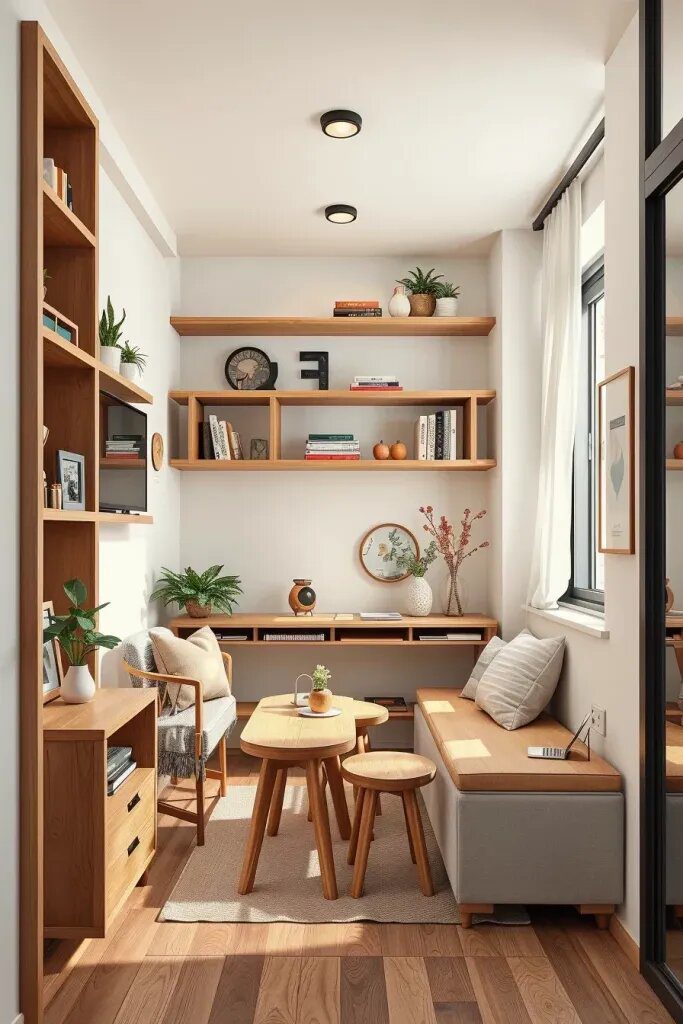
I was surprised at how much of a difference following Japandi design principles made in my small city apartment. By getting rid of bulky furniture, opting for wall shelves instead of cabinets, and incorporating off-white and natural wood decor, the space felt more open and peaceful. According to Better Homes & Gardens, city dwellers love Japandi for its ability to maximize space effectively.
A lot of small homes don’t have much going on in terms of vertical design. So, when you’re decorating, think about whether you want to go with slim, tall shelves or larger, high-reaching shelving units to draw the eye up and play around with different sizes.
Designing Japandi Homes with Sustainable Practices
You know, I’m really into Japandi design because it’s all about being sustainable. Whenever I shop for things, I always try to find items that are well-made, will stand the test of time, and will still be in style years from now. It’s not just about aesthetics; Japandi is like a lifestyle that encourages making eco-friendly choices.

Hey, I recommend checking out FSC-approved wood furniture, natural fabrics, and handmade pieces from local artisans. Bamboo, old wood, and stone are great materials to look for. Avoid cheap plastic items and try investing in fewer, but high-quality, well-designed pieces. Look for paints with low or no volatile organic compounds and choose furniture with rugs made from wool, cotton, or jute. It’s all about making conscious choices for a more sustainable and eco-friendly home decor!

Hey there! I recently installed hemp curtains and clay-based paint in my home to not only help the environment but also make sure the air quality indoors is top-notch. I read on The Spruce that sustainable design is becoming a big deal in interior design, and Japandi style really nails it. It’s all about merging sustainability with style, and I’m all for it!
Are you looking for other options? How about going solar with some stylish shades, picking up some eco-friendly party decorations, or starting an indoor herb garden? These are great ways to add some sustainable living touches to your Japandi style.
Creating A Mindful Work-From-Home Space
One great thing about Japandi interior design is how it creates a nice, productive space for working from home. I love mixing Scandinavian fabrics with Japanese-style organization because it really helps declutter and simplify things around the house. And having natural colors and materials around just makes it easier to focus and feel calm, especially when you’re working with a bunch of people.
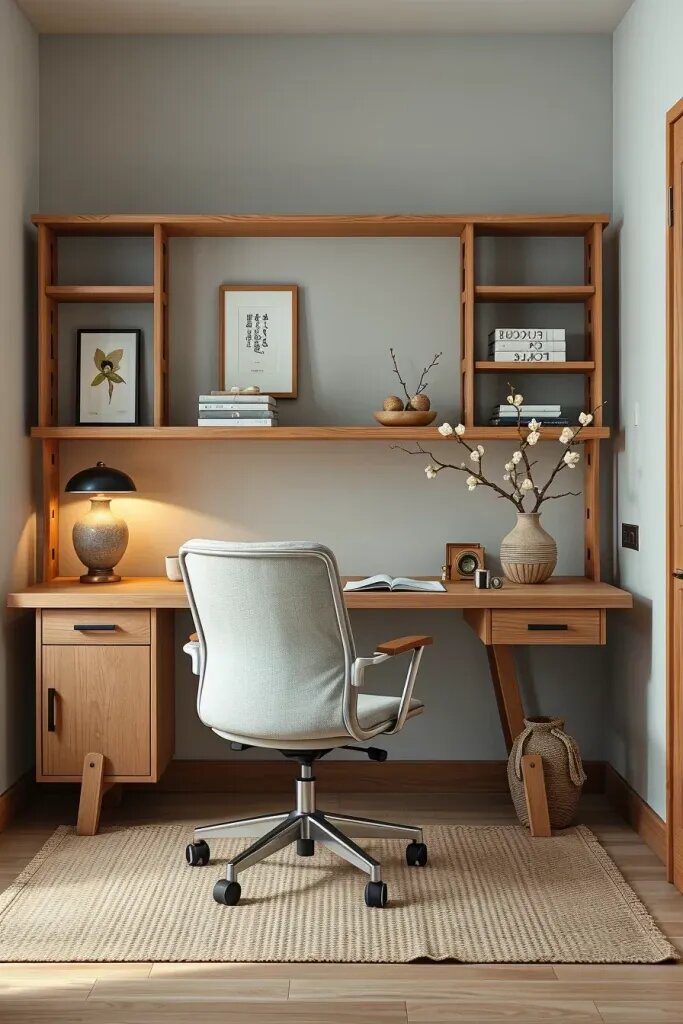
If you’re going for a Japandi vibe in your home office, I recommend a desk made of oak or ash wood with sleek legs. It’s important to have a comfy chair made of linen or vegan leather that’s good for your back. Keep the accessories minimal; a paper lantern or a simple vase with one flower will give the space some style without cluttering it up. Opt for covered storage like floating shelves or cabinets with doors to keep things neat. Adding a tatami mat or jute rug on the floor will add some texture and really bring the room together!

I truly believe that having a neat work space not only makes it visually appealing but also has a positive impact on our mindset. I recently read an article in Architectural Digest that highlighted how incorporating elements of Japandi style into home offices can reduce stress and enhance focus. Inspired by this, I revamped my study to reflect the Japandi concept and immediately noticed a boost in my productivity. I found myself feeling less overwhelmed and more in control of my work environment.
We could really brighten up this area with some good lighting. Adding more natural light and even putting in some LED strip lights behind the shelves could really make this space more functional and give it a nice look.
Avoid these common mistakes for a cozy Japandi home
Japandi design is all about finding the right balance so your home doesn’t end up looking too simple or too chilly. I always tell my clients to start off with a moderate approach and see how it feels. It’s all about finding that sweet spot!

You know, I’ve noticed that when people start adding too many decorations, it can quickly turn into clutter. In Japandi style, it’s not about having a ton of stuff. Each piece should have a purpose. So instead of filling your walls with a gallery of art, try having one standout framed piece. And when it comes to flowers, maybe just opt for a single branch in a tall vase instead of a whole bouquet.
Oh, and mixing different types of wood can also be tricky. Stick to just a couple of wood species, like light oak and walnut, to keep things looking cohesive. And when choosing furniture, go for simple designs with clean lines and corners. That way, you’ll achieve that minimalist Japandi look we all love.

I found out that when I have too many throws and pillows in my living room, it starts to look more Scandinavian cozy than true Japandi style. Bobby Berk suggests going for a few high-quality, solid-colored textiles like wool, linen, and cotton for a more earthy feel.
Hey there! I think we could include more details on different types of wall finishes in this section. Opting for matte textures over glossy ones can really enhance the calming vibe that’s so important in Japandi design. What do you think?
Seasonal Updates For Japandi Style Homes
You know, a common misconception is that Japandi homes always look the same. But hey, you can actually switch things up each season to give it a fresh vibe without losing that peaceful vibe. Just try mixing up textures, experimenting with different colors, all while staying true to that minimalist aesthetic. You’ll be surprised how easy it is to keep your Japandi design feeling cozy in any kind of weather!

Hey there! If you’re looking to spruce up your home for spring, I recommend trying out some light and airy colors like pastel green or blush. Consider swapping out a cushion or curtain for a fresh look.
For a cozy summer bedroom, opt for soft and soothing materials like bamboo or linen. In the fall, warm things up with some red-toned throws. And in the winter, create a cozy ambiance with candles and soft lighting.
One tip to keep in mind is to always replace rather than add. Try updating your decor one piece at a time, rather than piling on more layers. It’s all about creating a space that feels just right for you!

Did you know you can achieve the same effect by switching up the accessories in your Japandi living room based on the season? We noticed that some of the small details really caught the eye of our visitors. According to the folks at House Beautiful, it’s a good idea to have a box of seasonal items handy that you can easily swap in and out to keep your home looking fresh and organized.
You know what would be cool? If we added some seasonal art prints to this section of the store. Imagine swapping out the artwork with nature-inspired pieces in the colors of each season. It could really bring a cohesive vibe to your home decor.
Final Thoughts On Embracing Japandi Living
Japandi home interior design is all about intention. Every object has a purpose and every space is utilized thoughtfully. Whether it’s the living room, bedroom, or home office, Japandi encourages us to be present and mindful in our surroundings. I believe this philosophy goes beyond just design—it influences the way I live my life.

Make sure your furniture stays clean and usable. I really like decorations that serve multiple purposes, like a bench that can double as storage and a tea tray. I prefer more neutral colors like taupe, bone, charcoal, and sage. Each room has a few Japanese accents that make a big statement, such as a shoji screen, a handmade bowl, and a bonsai tree.

When I decided to go with a Japandi style for my home, it really made me think about how I interact with the space and all the things I have. I’ve grown to appreciate the serene beauty of slightly imperfect and organic items. According to Elle Decor, Japandi also promotes mindfulness and sustainability, which are values that really resonate with me.
To really dive deep into this section of the report, let’s think about sustainability too. By incorporating eco-friendly products and showcasing art from local artists, we’re truly embodying the Japandi vibe.
Hey there! Have you heard about Japandi home interior design? It’s all about finding that perfect balance in our lives and creating a space that feels cozy and clear. If you’ve been inspired by this concept or have any tips to share, I’d love to hear from you! Feel free to drop a comment and let’s keep the conversation going about creating beautiful living spaces.



